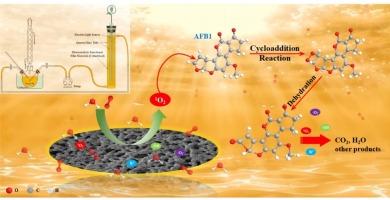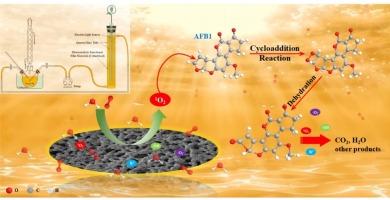Design and construction of stainless-steel-mesh-reinforced polyimide/silver phosphotungstate/PVDF photocatalytic films for degradation of aflatoxin B1 in peanut oil
IF 9.8
1区 农林科学
Q1 CHEMISTRY, APPLIED
引用次数: 0
Abstract
Photocatalytic technology can efficiently degrade aflatoxin B1 (AFB1) under ambient conditions while preserving peanut oil quality. Stainless-steel-mesh-reinforced photocatalytic functional films were successfully constructed using a bonding method. MPDF film, prepared using polyvinylidene fluoride (PVDF) as the binding agent, overcomes the problem that active sites are easily covered by the binding agents and exhibits excellent photocatalytic performance. Reduced agglomeration of active components and increased specific surface area enhance the photoelectric performance of MPDF and the reactive oxygen species generation. AFB1 decomposition begins with a 1O2-induced cycloaddition at the C![]() C bond in the difuran ring. Under optimized conditions, the rate constant of AFB1 degradation was 35.9778 h−1. After MPDF was used continuously for 24 h, the AFB1 degradation rate remained at 92.69 %, and the key quality parameters of peanut oil still met required standards. This work provides a novel perspective on the practical application of photocatalytic technology within the edible oil industry.
C bond in the difuran ring. Under optimized conditions, the rate constant of AFB1 degradation was 35.9778 h−1. After MPDF was used continuously for 24 h, the AFB1 degradation rate remained at 92.69 %, and the key quality parameters of peanut oil still met required standards. This work provides a novel perspective on the practical application of photocatalytic technology within the edible oil industry.


不锈钢网增强聚酰亚胺/磷钨酸银/PVDF光催化膜降解花生油中黄曲霉毒素B1的设计与构建
光催化技术可以在保证花生油品质的前提下,有效地降解黄曲霉毒素B1 (AFB1)。采用键合法成功构建了不锈钢网增强光催化功能膜。以聚偏氟乙烯(PVDF)为结合力制备的MPDF膜,克服了活性位点容易被结合力覆盖的问题,具有优异的光催化性能。减少了活性组分的团聚,增加了比表面积,增强了MPDF的光电性能和活性氧的生成。AFB1的分解开始于在二呋喃环的CC键上发生o2诱导的环加成反应。优化条件下,AFB1降解速率常数为35.9778 h−1。MPDF连续使用24 h后,AFB1的降解率保持在92.69 %,花生油的关键质量参数仍达到要求标准。这项工作为光催化技术在食用油工业中的实际应用提供了一个新的视角。
本文章由计算机程序翻译,如有差异,请以英文原文为准。
求助全文
约1分钟内获得全文
求助全文
来源期刊

Food Chemistry
工程技术-食品科技
CiteScore
16.30
自引率
10.20%
发文量
3130
审稿时长
122 days
期刊介绍:
Food Chemistry publishes original research papers dealing with the advancement of the chemistry and biochemistry of foods or the analytical methods/ approach used. All papers should focus on the novelty of the research carried out.
 求助内容:
求助内容: 应助结果提醒方式:
应助结果提醒方式:


